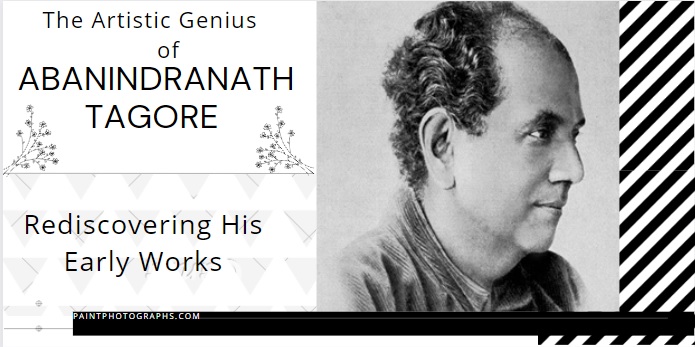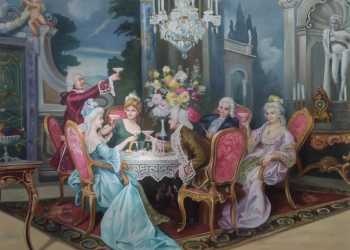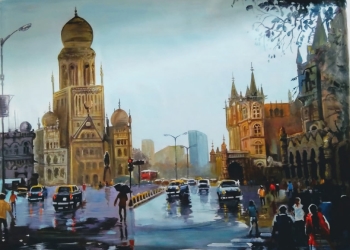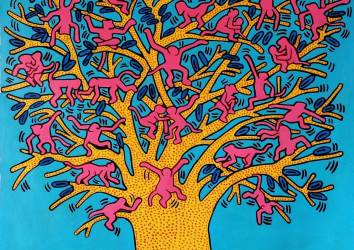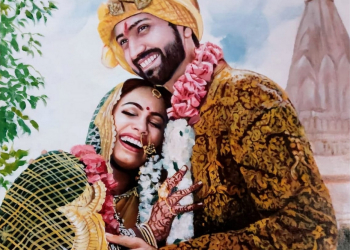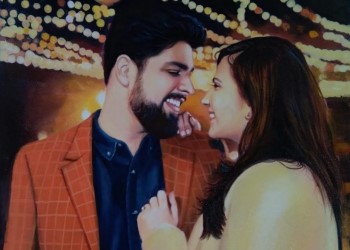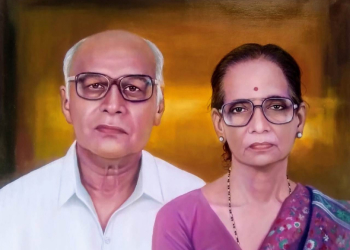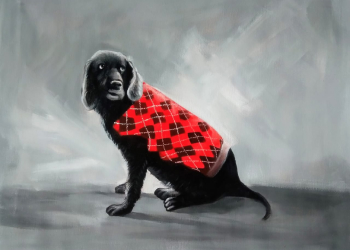In this post, we discuss the contributions of Ababnindranth Tagore to modern Indian art and his early works of watercolor paintings
Introduction to Abanindranth Tagore
Abanindranth Tagore was one of the most influential artists, authors, and thinkers who radically influenced the direction of Indian art. Founder of the Indian Society of Oriental Art and Bengal School of Art, his contributions to the Indian art movement are immense. In this essay, we will cover his influence on Indian art and his early works.
In one of our earlier essays, we covered the pioneer of Indian art and the romantic paintings Raja Ravi Ravi Varma, known as the Prince among painters and a painter among Princes.
About Raja Ravi Varma’s art, Rabindranath Tagore Nobel laureate, poet, painter, philosopher, and artist said in Chinna Patrabali (12 May 1893), “Today the entire morning went looking at the paintings of Ravi Varma. I liked them very much. The secret of their appeal is in reminding us how precious our own culture is to us in restoring our inheritance.”
Little did Rabindranath Tagore realize his own nephew, Abanindranth Tagore will usher in an art revolution in the country, that will take Indian art on a new trajectory.
The start of the last century was a pivotal moment in the history of Indian art, and it's all thanks to Abanindranath Tagore, who is rightfully hailed as its father. His incredible paintings signify a departure from the Western art styles, prevalent in India at the time, and instead, embrace the rich heritage of our country.
Handmade Art Reproductions & Landscape Paintings
Birth and early life of Abanindranath Tagore
Abanindranath was born on August 7, 1871, in Jorasanko, Calcutta to his mother, Saudamini Devi, and his father, Gunendranath Tagore. He was the nephew of the Noble Laureate poet and philosopher Rabindranath Tagore. Abanindranath's first formal training in pastel, watercolor, and life study was supervised by his private tutor, Signor Gilhardi. For instructions in oil paintings and portraiture, he attended the studio of Charles Palmer, an English painter. In 1895, he painted the Krishna-Lila series, which showcased a unique fusion of European and Indian styles. When E.B. Havell, the principal of the Calcutta School of Art, saw these paintings, he was impressed and offered Abanindranath the position of Vice-principal of the School. Under Havell's guidance, he thoroughly studied Mughal and Rajput styles of painting.
Why is Abanindranath Tagore famous?
Abanindranath Tagore is renowned for his contribution to the Indian art scene as a painter and the creator of the Bengal School of Art (To know more about the history of Bengal School check our earlier post on the history of art movements). He is known for his unique style that combined traditional Indian techniques with Eastern art concepts, giving birth to a new form of art.
R. Siva Kumar noted art historian, and critic explains Abanindranath’s contributions, 'The social space that Abanindranath narrativized as an artist-flaneur is thus the subject of the Orientalist artist/writer read from the obverse. He reclaims the colonial subjects' right to narrate their stories that was arrogated to themselves by the colonial rulers and perpetuated by presenting their readings as 'objective'. “ In essence, Abanindranth Tagore was perhaps the first Indian artist, to attempt decolonization, long before India’s Independence. And much longer before the word was added to the lexicon
Abanindranath's work has had a significant impact on Indian art, inspiring future generations to embrace their cultural heritage and create art that reflects it.
Abanindranath Tagore's position in Modern Indian art is truly unique and comparable only to his uncle Noble Laureate Rabindranath Tagore in the realm of literature. They both embody the very essence of Indian culture. But what sets them apart was their ability to infuse traditional Indian beliefs and stories with modern forms of beauty and expression. It's awe-inspiring how they both revolutionized their respective fields, leaving an indelible mark on Indian history and culture.
His ability to absorb and assimilate techniques and styles from all over the world is simply uncanny. He fearlessly incorporated the secrets of painting art from both Eastern and Western masters, infusing them with his own unique brand of eclecticism. Harmonizing both Eastern and Western points of view in a way that defies description.
But what truly sets Abanindranath Tagore apart are the leading traits of his miniature paintings. They possess an intensely romantic and lyrical quality, a dreamy and mystical treatment of his subjects that lifts them to a realm far beyond the confines of mere naturalism. It's a testament to his unparalleled skill as an artist, and an inspiration to all who seek to push the boundaries of what is possible in the world of art.
The extremely wide range of his vision theme and techniques makes it very difficult to group his works under any leading characteristics or dominating tendencies. And it is almost impossible to put any label on the general character of Abanindranath Tagore’s works or to characterize the leading phases of his creative brush.
Order Your Portrait Painting from Photo today!
10 Early works of Abanindranath Tagore
The current post is confined to presenting some of the earliest paintings of his pioneering attempt to recover the lost language of Indian aesthetics in Indian art. They are small watercolor paintings. Their subjects are Indian and Eastern. They depict stillness and listening to the within.
These masterpieces were created during the period of 1902-15 when Abanindranath Tagore held the esteemed position of Vice Principal at the Government School of Art in Calcutta. It's truly remarkable how one individual could spark such a profound artistic revolution that would forever shape the course of Indian art. To the extent possible, the paintings are presented chronologically.
Abhisarika
The charming painting depicts a lady inspired by the description of the rainy season in Kalidasa's Rtu-Samhara (Seasons), Verse X, was painted in 1892 and represents the artist's earliest attempt at depicting Indian themes in an Indian manner until he discovered the appropriate Indian style.
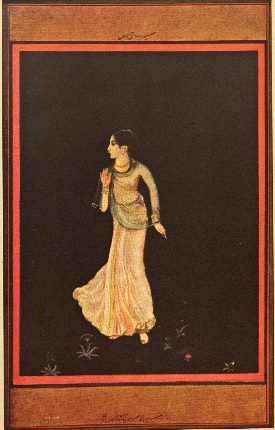 Abhisarika by Abanindranath Tagore (Image Credits: Indianculture.gov.in)
Abhisarika by Abanindranath Tagore (Image Credits: Indianculture.gov.in)
Title: Abhisarika
Creator: Abanindranath Tagore
Date Created: 1892
Physical Dimensions: 9.5 inches x 6.25 inches (24.13 cm x 15.87 cm)
Medium: Water Color on paper
Location: Calcutta Museum, Kolkata, India
In the painting, there is a sense of solidity and realism that reflects the artist's early training in Western art. The figure is dressed in a pink saree with pleated folds and a transparent scarf (Odna) through which the subject's complexion is visible in a sensual manner, inspired by the attire of women common in the region of Uttar Pradesh (also known as United Province in the artist's time) and Bihar. According to Havell," Even if the artist has suggested a Pompeian motif, he has contrived to give a distinctive note by sincere Indian feeling he brings to all his works.”
The artist had the opportunity to study the life and lifestyle of everyday people and villagers during his travel to Monghyr. The sensitive pose and the gesture lend a uniqueness to the figure that is captivating in its Indian essence.
Summer
The painting titled "Summer" by Abanindranath Tagore is one of a series of paintings, painted in 1900. Possibly inspired by verse III or verse XXVIII of the summer section of Kalidasa's Rtu-Samhara (Seasons)
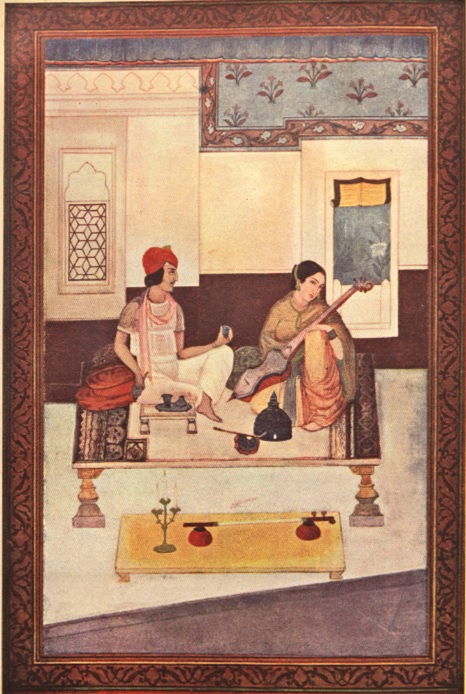 Summer by Abanindranath Tagore (Image Credits: Indianculture.gov.in)
Summer by Abanindranath Tagore (Image Credits: Indianculture.gov.in)
Title: Summer
Creator: Abanindranath Tagore
Date Created: 1900
Physical Dimensions: 9 inches x 6 inches (22.86 cm x 15.24 cm)
Medium: Water Color on paper
Location: Calcutta Museum, Kolkata, India
The painting depicts a couple wearing traditional costumes that the artist studied in Bihar during his visit to Moghyr. The architectural setting, influenced by Mughal monuments, is used in a way that complements the atmosphere of Kalidasa's mystic romantic descriptions.
The painting "transports us to an old world idyllic scene of grateful shade, delicious music, and cool sherbet, and is thoroughly Indian in style, treatment, and conception."
Spring
Another painting from the same series titled "Spring" by Abanindranath Tagore painted in 1900. Possibly inspired by verses X and XI of Kalidasa's Rtu-Samhara (Seasons).
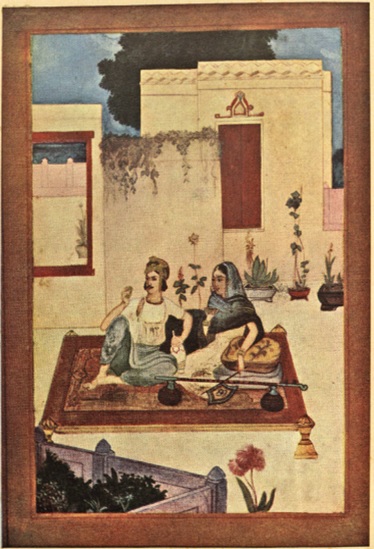 Spring by Abanindranth Tagore (Image Credits: Indianculture.gov.in)
Spring by Abanindranth Tagore (Image Credits: Indianculture.gov.in)
Title: Spring
Creator: Abanindranath Tagore
Date Created: 1900
Physical Dimensions: 6.87 inches x 4.62 inches (17.44 cm x 11.73 cm)
Medium: Water Color on paper
Location: Calcutta Museum, Kolkata, India
Order Your Portrait Painting from Photo today!
The miniature painting depicts a couple seated in the open courtyard of the house on a carpet (galicha) enjoying a quiet time with each other with drinks in hand. The lady is holding a glass in one hand while her other hand rest on a cushion holding a traditional rural hand fan (haath pankha). The man is holding his glass in one hand and the drinking jar in his other hand, while his back rests on a big side pillow (takia). Shrubs, plants, and flowers can be seen growing around the courtyard symbolizing the spring
Traveler and the Lotus
Another delightful early miniature painting work of Abanindranath Tagore. Painted in 1900, inspired by Kalidasa's Rtu Samhara. The painting depicts a traveler contemplating the beauty of a lotus picked from a nearby pond. Perhaps reminding him of his beloved at his faraway home waiting for him.
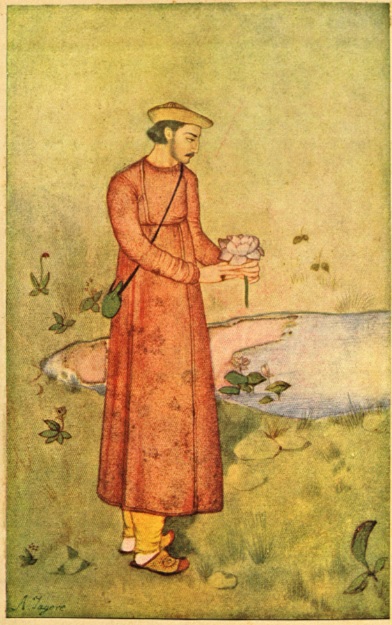 Traveler and the Lotus by Abanindranth Tagore (Image Credits: Indianculture.gov.in)
Traveler and the Lotus by Abanindranth Tagore (Image Credits: Indianculture.gov.in)
Title: Traveller and the Lotus
Creator: Abanindranath Tagore
Date Created: 1900
Physical Dimensions: 8.25 inches x 5.25 inches ( 20.95cm x 13.33cm)
Medium: Water Color on paper
Location: Calcutta Museum, Kolkata, India
The influence of Mughal painting, which the artist studied deeply can be clearly discerned from the flowering plants near the edge of the pond. A convention of the Mughal miniature painting. The echo of European training can be observed in the shadow of the standing man, an element the artist will de-emphasize in his mature period. Although the artist is reticent in his work and has yet to find his technique, we can already make out the faint outlines of his technique that will become his signature style.
According to Havell, the drawing, "Shows the unconscious grace and 'naivete' of feelings which are attractive in all of Mr. Tagore's compositions."
Rukmini writing letter to Krsna (Krishna)
The miniature painting, which is of unknown date, is one of the earliest examples of charming color schemes in cool and harmonious color tones. The composition depicts a lady writing a letter while seated on the floor near the evening lamp. The woman depicted is Rukmini, the daughter of the King of Vidarbha. She fell in love with Krsna (Krishna) and secretly chose him as her Lord despite belonging to a rival clan. Complications arose when her brother proposed marriage to Sisupala, Krsna's sworn enemy (Krishna).
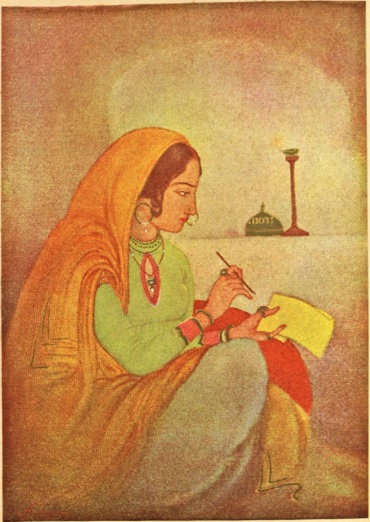 Rukmini Writing letter to Krsna by Abanindranath Tagore (Image Credits: Indianculture.gov.in)
Rukmini Writing letter to Krsna by Abanindranath Tagore (Image Credits: Indianculture.gov.in)
Title: Rukmini writing letter to Krsna (Krishna)
Creator: Abanindranath Tagore
Date Created: Uncertain
Physical Dimensions: 6.5 inches x 4.75 inches (16.51 cm x 12.06 cm)
Medium: Water Color on paper
Location: Calcutta Museum, Kolkata, India
Order Your Custom Handmade Oil Portrait Painting from Photo today
Saddened by this unhappy development, she wrote a letter to her Lord Krsna (Krishna) pleading with him to come to her rescue and save the situation. Krsna came to her call for help and vanquished Sisupala, carrying Rukmini away and marrying her. The story is based on a scene from the Mahabharata.
It is fascinating to see the narrativization of the story from Mahabharata in painting form. It is even more fascinating to note the two main characters of the story, Rukmini and Krishna, around whom the story revolves, the absence of Krishna. Not even a symbolic hint of Krishna’s presence in the painting. (If you are in the mood to see Krishna paintings check our gallery pages)
Buddha and Sujata
Being a sensitive artist, the spiritual heritage of India would have naturally attracted Abanindranath Tagore. The various Gods and Goddess of India and the Spiritual and holy men (Sadhus) and women (Sadvis) of the country. This miniature painting reflects that. It was painted shortly before the 1903 Delhi exhibition. The painting depicts a scene where Sujata brings votive offerings to Buddha. She mistakes him for the Wood God. The offerings are sweetened milk and rice (payasa). The offerings are presented in a golden bowl. The painting was first exhibited at the Delhi exhibition.
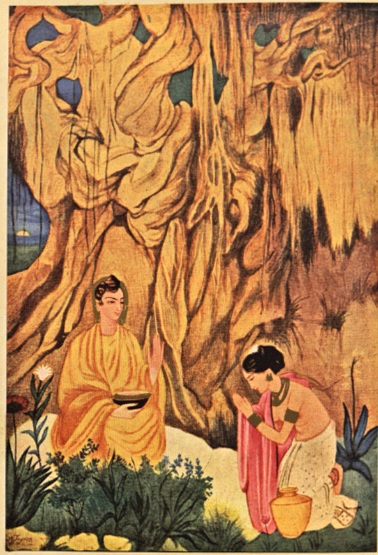 Buddha and Sujata by Abanindranath Tagore (Image Credits: Indianculture.gov.in)
Buddha and Sujata by Abanindranath Tagore (Image Credits: Indianculture.gov.in)
Title: Buddha and Sujata
Creator: Abanindranath Tagore
Date Created: 1903
Physical Dimensions: 7.12 inches x 5 inches (18.08 cm x 12.7 cm)
Medium: Water Color on paper
Location: Calcutta Museum, Kolkata, India
The composition centers around the Bodhidruma, the banyan tree where Buddha attained his transcendental knowledge which has become the symbol of Buddhahood, characterized by solemnity and majesty. The introduction of the woman with her offering of sweetened milk and rice (payasa) in the composition softens the majesty of the scene. Buddha accepts her offering to break his fast of several weeks. The majestic scene is framed by the scrubs and greenery in the foreground and the giant banyan tree in the background. A glimpse of the sunrise on the left of the background adds a symbolic spiritual element to the lyrical setting of the overall majesty of the painting.
According to Havell, "Mr. Tagore has expressed the serene dignity and spirituality of the Buddha with the same simplicity and depth of feeling he has given to the grace and sweetness of Sujata's adoration.
Dewali
Another charming and moving composition by Abanindranth Tagore, possibly painted in 1903, is the Dewali (Diwali), the Hindu festival of lights celebrated across India with great enthusiasm.
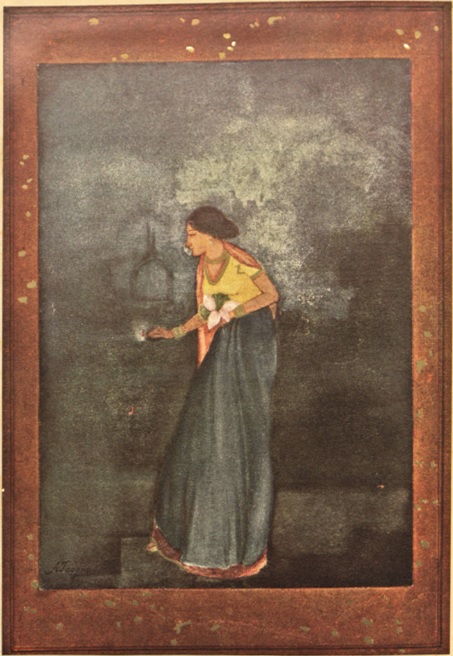 Dewali by Abanindranth Tagore (Image Credits: Indianculture.gov.in)
Dewali by Abanindranth Tagore (Image Credits: Indianculture.gov.in)
Title: Dewali
Creator: Abanindranath Tagore
Date Created: 1903
Physical Dimensions: 8.5 inches x 6 inches ( 21.51 cm x 15.24 cm)
Medium: Watercolor on paper
Location: Calcutta Museum, Kolkata, India
The painting depicts a woman descending to the river Ganga with a few lotuses on her left hand and a tiny lamp in her right, in the fading twilight, as darkness falls.
The painting seems to be inspired by the ritual Hindu women undertake during Dipawali, in the month of October (month of Kartik as per the Hindu calendar) when they step down to the waters of the Ganges to float their lamps in honor of Goddess Lakshmi and pray for the good fortune of the family.
The Siddhas of The Upper Air
Possibly painted in 1905, the charming miniature painting is inspired by Kalidas’s Meghduta, (Cloud Messenger)
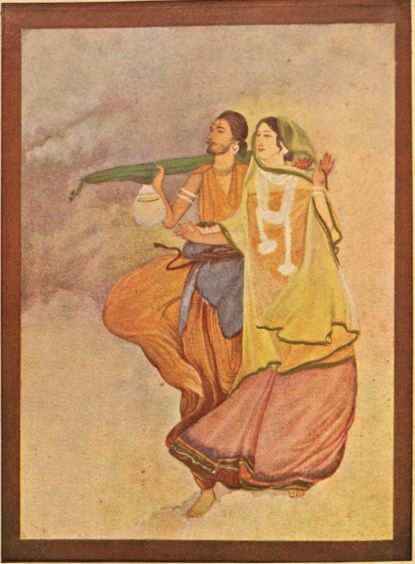 Siddhas of the Upper Air by Abanindranth Tagore (Image Credits: Indianculture.gov.in)
Siddhas of the Upper Air by Abanindranth Tagore (Image Credits: Indianculture.gov.in)
Title: The Siddhas of The Upper Air
Creator: Abanindranath Tagore
Date Created: 1905
Physical Dimensions: 7.75 inches x 5.5 inches ( 19.68cm x 13.97cm)
Medium: Water Color on paper
Location: Calcutta Museum, Kolkata, India
Commenting on the series of paintings, Ananda Coomaraswamy, the great art historian and pioneer of Indian art history, said, "The tenderness, and grace and unapproachable Indianess of these delicate watercolors is overwhelming. They are the perfect expression of Indian conception in an universal language. They reveal the soul of a people, not crudely or superficially, but utterly; to those that have eyes to see and ears to hear, they have mingled reticence and revelations that belongs to great art. Such work, a true expression of the spirit of Indian nationality, is the perfect flowering of the old tradition, a flower that speaks not only of the past loveliness but is strong and vigorous with promise of abundant fruit."
A scene from Omar Khayyam
The delightful miniature painting is inspired by Omar Khayyam. The painting depicts lovers' quarrel, possibly because the man has arrived late to their rendezvous for their tryst. The lady is clearly annoyed with the man. And the man trying to pacify her by offering her a rose plucked from the nearby rose bush. With the simple yet lyrical setting, the relatable theme, and the subtle brush strokes that will go on to become his signature style, Abanindranth manages to converge the elements to create an ethereal experience for the viewer.
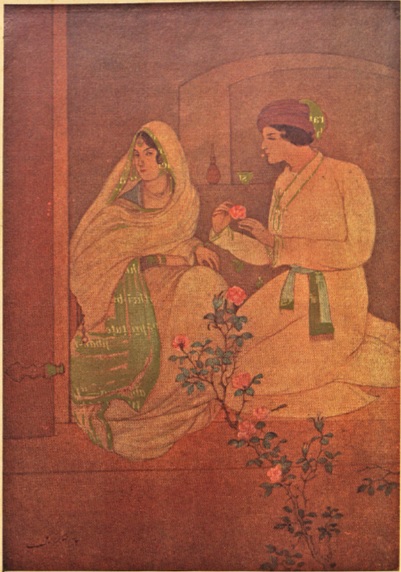 Scene from Omar Khyam by Abanindranth Tagore (Image Credits: Indianculture.gov.in)
Scene from Omar Khyam by Abanindranth Tagore (Image Credits: Indianculture.gov.in)
Title: A scene from Omar Khayyam
Creator: Abanindranath Tagore
Date Created: 1905
Physical Dimensions: 7.75 inches x 5.5 inches ( 19.68cm x 13.97cm)
Medium: Water Color on paper
Location: Calcutta Museum, Kolkata, India
The painting clearly shows the evolution of the artist and maturity in Ababnindranath's work, with a definite style, texture, and mood. With a flair for drama. According to Havell, "In the illustrations of Omar Khayyam, we see for the first time, Aabanindranath's style. For the first time, we see texture, atmosphere, deep interest in portraiture, and dramatic expression."
Portrait of Abdul Khalik
The painting Portrait of Abdul Khalik is another delightful example of Abanindranth Tagore's style, which blended traditional Indian portrait painting techniques with modern portrait painting influences.
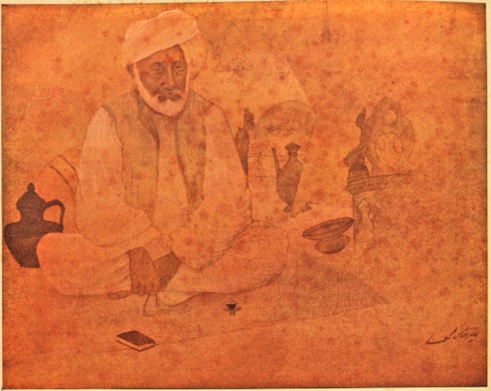 Portrait of Abdul Khalik by Abanindranth Tagore (Image Credits: Indianculture.gov.in)
Portrait of Abdul Khalik by Abanindranth Tagore (Image Credits: Indianculture.gov.in)
Title: Portrait of Abdul Khalik
Creator: Abanindranath Tagore
Date Created: Unknown
Physical Dimensions: 8 inches x 6.50 inches ( 20.32cm x 16.51cm)
Medium: Water Color on paper
Location: Calcutta Museum, Kolkata, India
The portrait painting is of Abdul Khalik, an art dealer, an acquaintance of the artist, who had his shop at Park Street Calcutta (now Kolkata). Dressed in the traditional Indian attire of dhoti, kurta, Bundi jacket, and turban. He is shown seated cross-legged in his shop. Surrounded by artifacts, facing the viewer. His right hand holding his prayer beads. A notebook lies near his feet. The composition of the painting is balanced and harmonious.
Conclusion
As can be seen from glimpses of his early works, his repertoire was vast and not amenable to straight jacketing of his works into defined styles, periods, or themes. In other words, Abanindranath’s body of work defies stereotyping. How do then we understand his artworks?
According to noted Indian art historian and art critic, R. Siva Kumar, 'Narration', was central to Abanindranath's art. The narrative impulse, as we have seen, informed both his landscapes and portraits, and they became involved and more engaging when they were inflected with narrative innuendoes.' To understand his artworks, we need to understand the narration behind them and the context of the painting.
R. Sivakumar writes in the introduction to his authoritative book, Paintings of Abanindranath Tagore (2008) that Abanindranath is an artist "' who is more talked about than seen. In this, he is like a classic that is little read but is a part of our cultural consciousness.”
Our endeavor with this post was to introduce and appreciate Ababnindranth Tagore's contributions to a new generation of art lovers through his early works.
And if it inspires a few of our readers to learn more about this great artist, we will consider our job well done.
About Us:
Paintphotographs.com is India's leading custom art platform. We turn your favorite photos, pics, and images into luxurious handmade portrait paintings. Our work includes handmade portraits, custom oil reproductions, charcoal drawings, and sketches. As a team of accomplished artists, we use museum-quality canvas, the best international brands of colors such as Winsor & Newton and Daler Rawney. We work with various mediums, including oil, acrylic, mixed media, graphite, and charcoal.
To order a custom handmade oil portrait painting you can visit our order now page. You can order custom Wedding Paintings, Couple Paintings, Memorial Paintings, Family Paintings, Baby portraits and Children Paintings, Photo to paintings, and Pet Portrait Paintings from Photo.
You can visit our pricing page to know the prices of our portrait paintings. To connect with us ping us on our chat messenger on the website, ping us on WhatsApp, call us at 918291070650, or drop us an email at support@paintphotographs.com
You can visit our gallery pages to see our work. We make photo to paintings, couple paintings, memorial paintings, Kids and Baby Portrait paintings, God & Religious Paintings, Old Photo to Paintings, Wedding couple Paintings & Marriage Portraits, Family Paintings, Pet Portrait Paintings, Radha Krishna Paintings, Oil Portraits of Gurus, Saints & Holy Men, Charcoal and Pencil Sketches, Custom Landscape & Cityscape paintings, Contemporary Art Reproduction & Replica Paintings, Old Master Reproduction & Replica Art, Monochrome and Black & White portrait paintings, Historical Portraits and Shivaji Maharaj Paintings, Celebrity & Political Leaders Portraits. We can also merge separate photos to create a single seamless painting called Composite portraits to add deceased loved ones to make a family oil portrait as though they were present.
Our custom handmade portraits make beautiful Anniversary Gifts, Engagement Gifts, Birthday Gifts, Retirement Gifts, Housewarming Gifts, Mother's Day gifts, and luxurious gifts for many important occasions.
Paintphotographs.com provides bespoke services for art patrons, interior designers, and architects. It helps you create the perfect pieces for residential and commercial projects and serves as a platform for artists to showcase their work.
If you are an art aficionado interested in writing a guest post on art, connect with us.
Want to read more? Check our reading recommendations below! Please refer to the Notes and Reference section for sources referenced in the article.
Like this story? Then you will love our podcasts on Spotify. Listen to our deep dives and fascinating stories from the art world. Join our nearly 20,000-strong community on Facebook, WhatsApp, and X.
Want to see our art? Join our community of 500,000+ subscribers on the Paintphotographs YouTube channel, Instagram, and Pinterest for some amazing art pics & art videos!
Recommended Pieces
Uncover the mystical beauty of Shri Krishna paintings and art through the ages | Paintphotographs
A Closer Look at the Stunning Paintings in Coca-Cola's Latest Ad “Masterpiece” | Paintphotographs
Ultimate 20 Best Oil Portrait Paintings of John Singer Sargent (Ranked) | Paintphotographs
How to Commission a Wedding Portrait Painting Online | Paintphotographs
The life and paintings of artist and painter KCS Paniker | Paintphotographs
Why is the Monalisa so famous? Monalisa's portrait painting history | Paintphotographs
Memorial Paintings - The Ultimate Guide to Commissioning one | Paintphotographs
Notes and reference section
https://www.google.co.in/books/edition/A_History_of_Indian_Painting/McSbSMhArFgC?hl=en&gbpv=1
Abanindranath Tagore his Early Work | INDIAN CULTURE
https://www.google.co.in/books/edition/Paintings_of_Abanindranath_Tagore/Pdb_nQEACAAJ?hl=en

